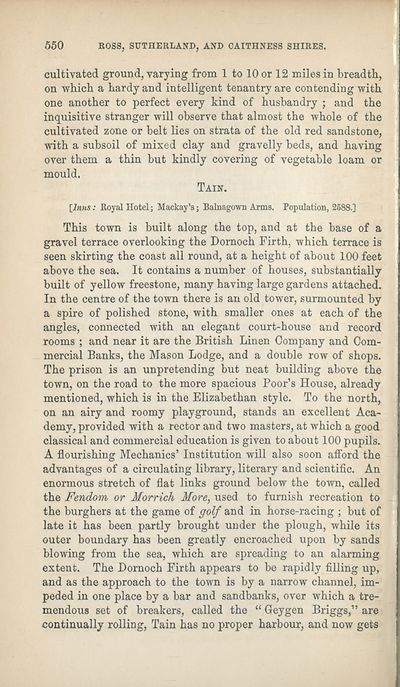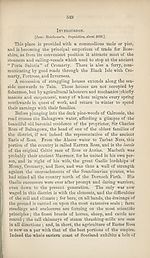Download files
Complete book:
Individual page:
Thumbnail gallery: Grid view | List view

550 ROSS, SUTHERLAND, AND CAITHNESS SHIRES.
cultivated ground, varying from 1 to 10 or 12 miles in breadth,
on which a hardy and intelligent tenantry are contending with
one another to perfect every kind of husbandry ; and the
inquisitive stranger will observe that almost the whole of the
cultivated zone or belt lies on strata of the old red sandstone,
with a subsoil of mixed clay and gravelly beds, and having
over them a thin but kindly covering of vegetable loam or
mould.
Tain.
[Inns: Royal Hotel; Mackay’s; Balnagown Arms. Population, 2588.]
This town is built along the top, and at the base of a
gravel terrace overlooking the Dornoch Firth, which terrace is
seen skirting the coast all round, at a height of about 100 feet
above the sea. It contains a number of houses, substantially
built of yellow freestone, many having large gardens attached.
In the centre of the town there is an old tower, surmounted by
a spire of polished stone, with smaller ones at each of the
angles, connected with an elegant court-house and record
rooms ; and near it are the British Linen Company and Com¬
mercial Banks, the Mason Lodge, and a double row of shops.
The prison is an unpretending but neat building above the
town, on the road to the more spacious Poor’s House, already
mentioned, which is in the Elizabethan style. To the north,
on an airy and roomy playground, stands an excellent Aca¬
demy, provided with a rector and two masters, at which a good
classical and commercial education is given to about 100 pupils.
A flourishing Mechanics’ Institution will also soon afford the
advantages of a circulating library, literary and scientific. An
enormous stretch of flat links ground below the town, called
the Fendom or Morrich More, used to furnish recreation to
the burghers at the game of golf and in horse-racing ; but of
late it has been partly brought under the plough, while its
outer boundary has been greatly encroached upon by sands
blowing from the sea, which are spreading to an alarming
extent. The Dornoch Firth appears to be rapidly filling up,
and as the approach to the town is by a narrow channel, im¬
peded in one place by a bar and sandbanks, over which a tre¬
mendous set of breakers, called the “ Gey gen Briggs,” are
continually rolling, Tain has no proper harbour, and now gets
cultivated ground, varying from 1 to 10 or 12 miles in breadth,
on which a hardy and intelligent tenantry are contending with
one another to perfect every kind of husbandry ; and the
inquisitive stranger will observe that almost the whole of the
cultivated zone or belt lies on strata of the old red sandstone,
with a subsoil of mixed clay and gravelly beds, and having
over them a thin but kindly covering of vegetable loam or
mould.
Tain.
[Inns: Royal Hotel; Mackay’s; Balnagown Arms. Population, 2588.]
This town is built along the top, and at the base of a
gravel terrace overlooking the Dornoch Firth, which terrace is
seen skirting the coast all round, at a height of about 100 feet
above the sea. It contains a number of houses, substantially
built of yellow freestone, many having large gardens attached.
In the centre of the town there is an old tower, surmounted by
a spire of polished stone, with smaller ones at each of the
angles, connected with an elegant court-house and record
rooms ; and near it are the British Linen Company and Com¬
mercial Banks, the Mason Lodge, and a double row of shops.
The prison is an unpretending but neat building above the
town, on the road to the more spacious Poor’s House, already
mentioned, which is in the Elizabethan style. To the north,
on an airy and roomy playground, stands an excellent Aca¬
demy, provided with a rector and two masters, at which a good
classical and commercial education is given to about 100 pupils.
A flourishing Mechanics’ Institution will also soon afford the
advantages of a circulating library, literary and scientific. An
enormous stretch of flat links ground below the town, called
the Fendom or Morrich More, used to furnish recreation to
the burghers at the game of golf and in horse-racing ; but of
late it has been partly brought under the plough, while its
outer boundary has been greatly encroached upon by sands
blowing from the sea, which are spreading to an alarming
extent. The Dornoch Firth appears to be rapidly filling up,
and as the approach to the town is by a narrow channel, im¬
peded in one place by a bar and sandbanks, over which a tre¬
mendous set of breakers, called the “ Gey gen Briggs,” are
continually rolling, Tain has no proper harbour, and now gets
Set display mode to:
![]() Universal Viewer |
Universal Viewer | ![]() Mirador |
Large image | Transcription
Mirador |
Large image | Transcription
| Antiquarian books of Scotland > Scotland/Scots > Black's picturesque tourist of Scotland > (684) |
|---|
| Permanent URL | https://digital.nls.uk/130036398 |
|---|
| Description | Thousands of printed books from the Antiquarian Books of Scotland collection which dates from 1641 to the 1980s. The collection consists of 14,800 books which were published in Scotland or have a Scottish connection, e.g. through the author, printer or owner. Subjects covered include sport, education, diseases, adventure, occupations, Jacobites, politics and religion. Among the 29 languages represented are English, Gaelic, Italian, French, Russian and Swedish. |
|---|

